The Sandy Bridge Preview
by Anand Lal Shimpi on August 27, 2010 2:38 PM ESTAdobe Photoshop CS4 Performance
To measure performance under Photoshop CS4 we turn to the Retouch Artists’ Speed Test. The test does basic photo editing; there are a couple of color space conversions, many layer creations, color curve adjustment, image and canvas size adjustment, unsharp mask, and finally a gaussian blur performed on the entire image.
The whole process is timed and thanks to the use of Intel's X25-M SSD as our test bed hard drive, performance is far more predictable than back when we used to test on mechanical disks.
Time is reported in seconds and the lower numbers mean better performance. The test is multithreaded and can hit all four cores in a quad-core machine.
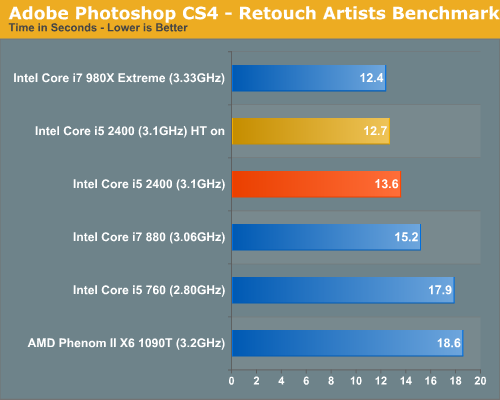
Right off the bat Sandy Bridge is killer. In our Photoshop test it’s faster than its closest quad-core price competitor, faster than its identically clocked Lynnfield, faster than AMD’s fastest and loses out only to Intel’s $999 Core i7 980X. That being said, it only takes about 9% longer to complete our benchmark than the 980X.
DivX 6.5.3 with Xmpeg 5.0.3
Our DivX test is the same DivX / XMpeg 5.03 test we've run for the past few years now, the 1080p source file is encoded using the unconstrained DivX profile, quality/performance is set balanced at 5 and enhanced multithreading is enabled:
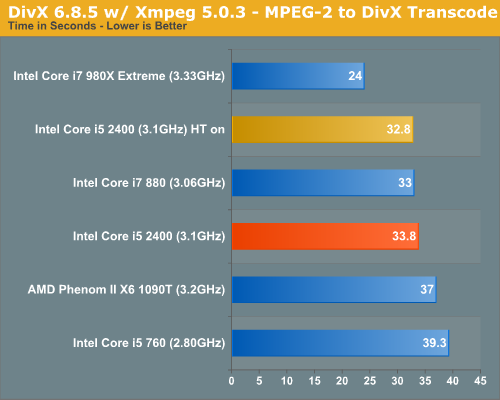
While not the most stressful encoding test, it’s still a valid measure of performance and once again, Sandy Bridge is faster than all. In this case we’re faster than the Core i5 760 (~16%) and just behind the Core i7 880. Clock for clock there's not a huge improvement in performance here (HT doesn't seem to do much), it's just a better value than the 760 assuming prices remain the same.
x264 HD Video Encoding Performance
Graysky's x264 HD test uses the publicly available x264 encoder to transcode a 4Mbps 720p MPEG-2 source. The focus here is on quality rather than speed, thus the benchmark uses a 2-pass encode and reports the average frame rate in each pass.
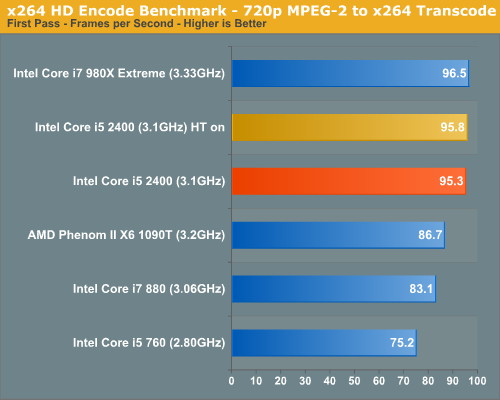
Lightly threaded performance is much improved - the 2400 is 14.6% faster than the Core i7 880.
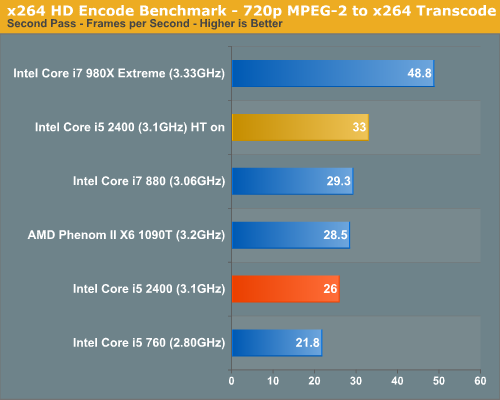
The actual encoding pass favors more threads, so we see a big improvement over the 760 (19%) but it falls short of the Core i7 880. Turn HT on and we get a 12.6% improvement over an identically clocked/configured Lynnfield.
Note that CPU based video encoding performance may not matter if Intel implemented a good video transcode engine in Sandy Bridge.
Windows Media Encoder 9 x64 Advanced Profile
In order to be codec agnostic we've got a Windows Media Encoder benchmark looking at the same sort of thing we've been doing in the DivX and x264 tests, but using WME instead.
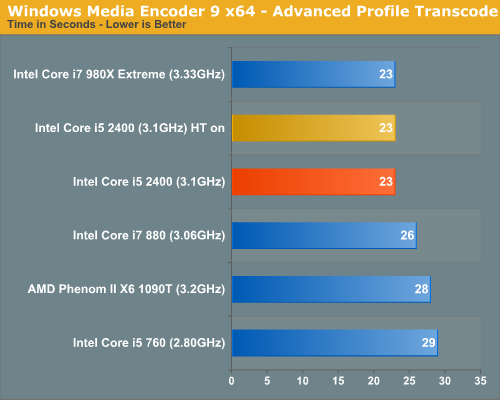
Performance in WME rarely scales anymore. Our benchmark doesn’t scale well beyond 4 cores and the only hope for performance are increases in clock speed or IPC. Sandy Bridge delivers the latter.
A 20% increase in performance vs. the similarly clocked 880 in a test that doesn’t scale with anything but IPC tells you a lot. Compared to the Core i5 760, Sandy Bridge is 26% faster.










200 Comments
View All Comments
AndreC - Saturday, August 28, 2010 - link
Hi there.. I`m currently a freelance 3D generalist.. and I was going to upgrade my old Core 2 Quad QX6700 with a Core i7 980X. But now i`m not that confident. Sandy bridge looks amazing, I was sad seeing the new socket for sandy bridge, it does not compell me to buy a new motherboard now... does anyone know if the 1366 socket will stick with the nex gen High end market? I dont want to shoot myself in the foot here.AndreC - Saturday, August 28, 2010 - link
Sorry dind`t read the last frase...Great Review btw. cheers
sdsdv10 - Saturday, August 28, 2010 - link
As noted in the Intel roadmap in the article, for at least part of 2011 they will be sticking with 1366 for the release of the Core i7 990X (to replace the 980X). However, after that the Intel performance platform will switch over to socket LGA-2011. Here is a quote from the articlea (page 3)."Original Nehalem and Gulftown owners have their own socket replacement to look forward to. In the second half of 2011 Intel will replace LGA-1366 with LGA-2011. LGA-2011 adds support for four DDR3 memory channels and the first 6+ core Sandy Bridge processors."
AndreC - Saturday, August 28, 2010 - link
Yeah.. as I said "Sorry dind`t read the last frase..." but thx anyway..It`s a shame to be always changing sockets, but probabily a necessity to evolve the technology.
Kaihekoa - Saturday, August 28, 2010 - link
Having the first chips target the mainstream market is a very smart move by Intel because that's where AMD makes it's money. I'm honestly not impressed by the performance numbers, but I am impressed by the overall performance, power consumption, and pricepoints for these next gen CPUs. What I'm really looking forward to is the performance segment of Sandy Bridge.mino - Saturday, August 28, 2010 - link
Intel's mainstream is not where AMD's is.Especially in 2011.
Ontario:
. . . CPU - above Atom, under everything else
. . . GPU - 5450/Sandy class
Lliano:
. . . CPU - 2C Sandy class
. . . GPU - 5650 class (at least 3x Sandy)
Bulldozer Desktop(8C):
. . . CPU - 4C Sandy Class
. . . GPU - discrete 5750+ class
So basically AMD's platform in the Intel's "mainstream" $200+ class will be a Bulldozer with discrete GPU. Aka AMD's high end stuff.
silverblue - Saturday, August 28, 2010 - link
Not sure I agree with that. From AMD's own figures, Bulldozer is significantly faster than STARS. It would be more realistic to expect Bulldozer to perform closely to Sandy Bridge, however we really need more benchmarks before we get a true idea. Bulldozer looks great on paper, but that's virtually all we have so far.In any case, you compared Bulldozer to "4C Sandy Class", which would be an 8-thread Sandy Bridge, and thus - at least relatively - high end. And I'm not getting into the core/module argument again... ;)
mino - Sunday, August 29, 2010 - link
What I wanted to point out is that Intel sees the 4C Sandy as a "mainstream" part.Reason being they are moving HUGE amounts (compared to AMD) of $150-$250 parts.
On the other hand, AMD sees the mainstream at $100-$200 and that is a Llano market.
For AMD, Zambezi is high-end that justifies discrete GPU.
And Yes, Bulldozer 8C should compare with 4C Sandy favorably, (it would mostly go to pricing).
tatertot - Sunday, August 29, 2010 - link
BD 8C is going to be up against 8C and 6C Sandy on LGA-2011 in the client space.mino - Monday, August 30, 2010 - link
am sure AMD WOULD like it that way. But no. Not really.8C Bulldozer versus 6C Sandy might actually be competitive.
However 32nm SOI is a new process so we might as well forget about 4GHz parts for now.
Also, Sandy 6C is Q4 part and 8C is most probably 2012 part.